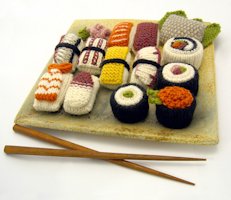
|
Some Common Myths Thought to be True - Myth 20
Myth 20: Sushi always Contains Fish
Inarizushi is a pouch of fried tofu typically filled with sushi rice alone. It
is named after the Shinto god Inari, who is believed to have a fondness for
fried tofu. The pouch is normally fashioned as deep-fried tofu, abura age).
Regional variations include pouches made of a thin omelette, chakin-zushi). It
should not be confused with inari maki, which is a roll filled with flavored
fried tofu.
|
| Sushi Platter | |
|
Uramaki, "inside-out roll" is a medium-sized cylindrical piece with two or more
fillings. Uramaki differs from other makimono because the rice is on the
outside and the nori inside. The filling is in the center surrounded by nori,
then a layer of rice, and an outer coating of some other ingredients such as
roe or toasted sesame seeds. It can be made with different fillings, such as
tuna, crab meat, avocado, mayonnaise, cucumber or carrots. In Japan, uramaki is
an uncommon type of makimono because of the outer layer of rice can be quite
difficult to handle with fingers.
|
|
| ⇦ Back to Myth 19 Return to Myth Choices Page 2 On to Myth 21 ⇨ | |